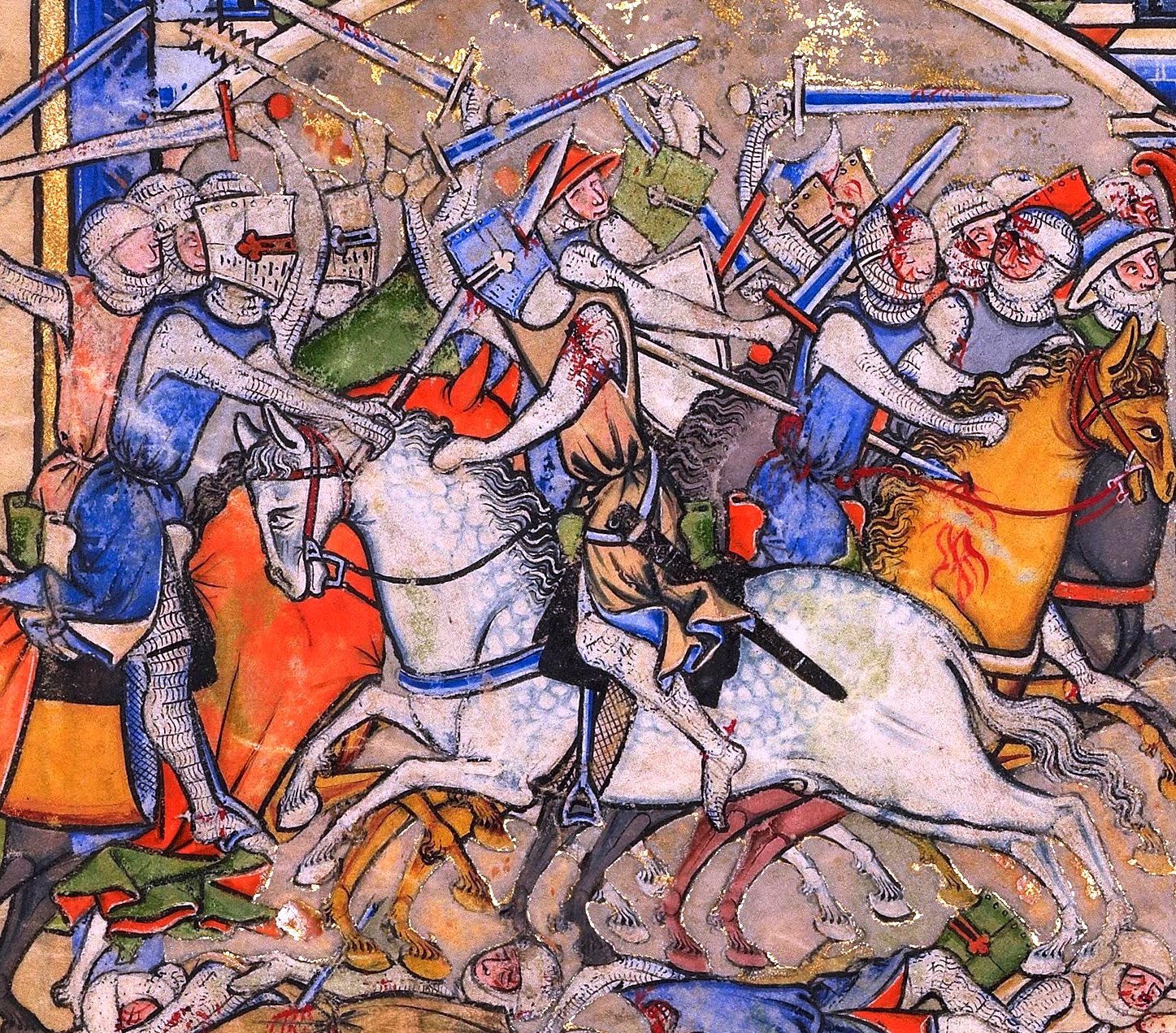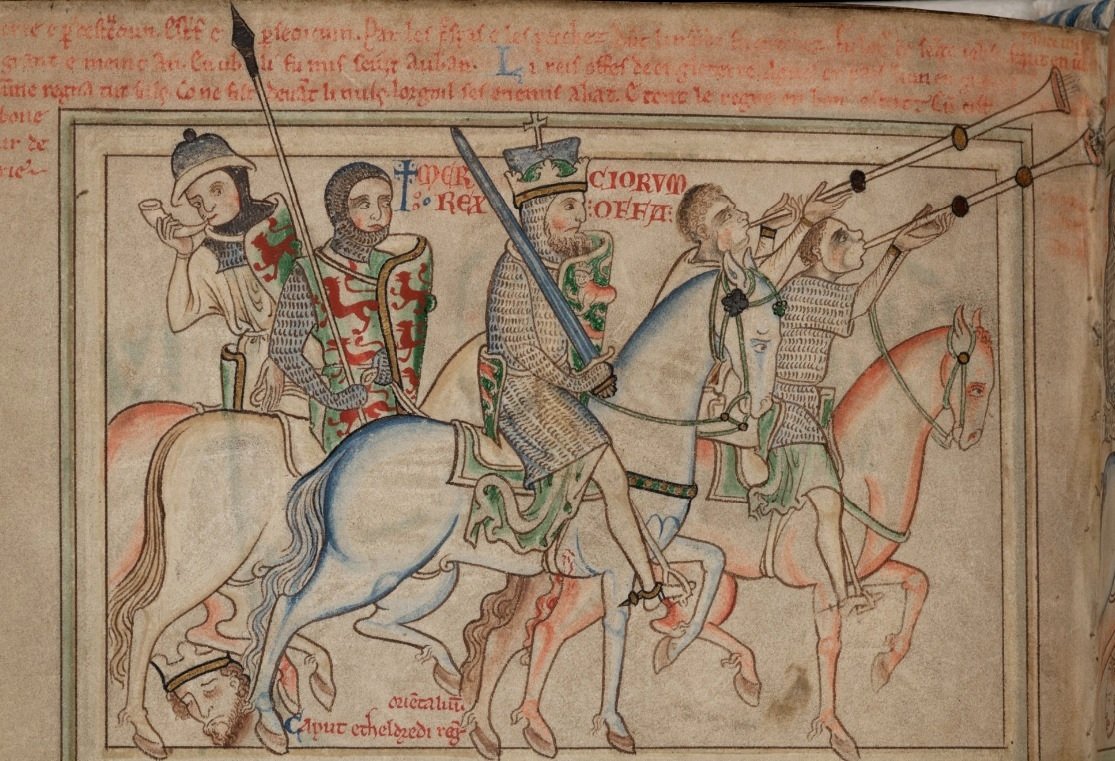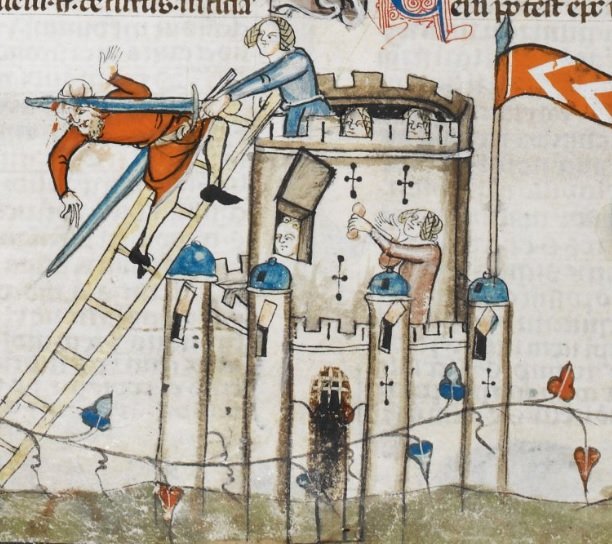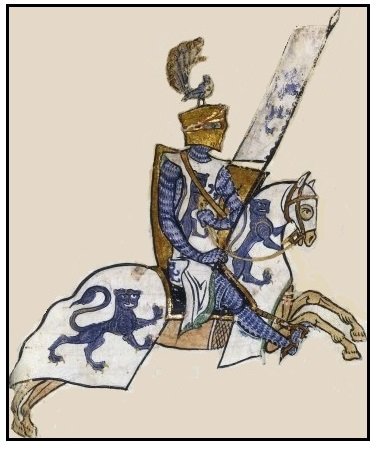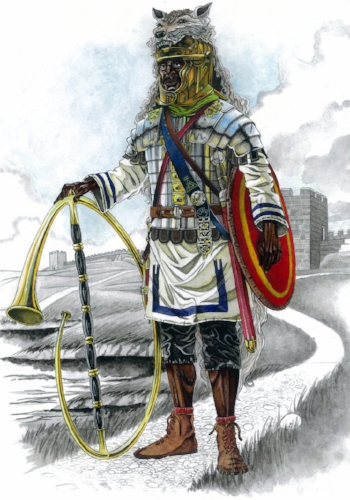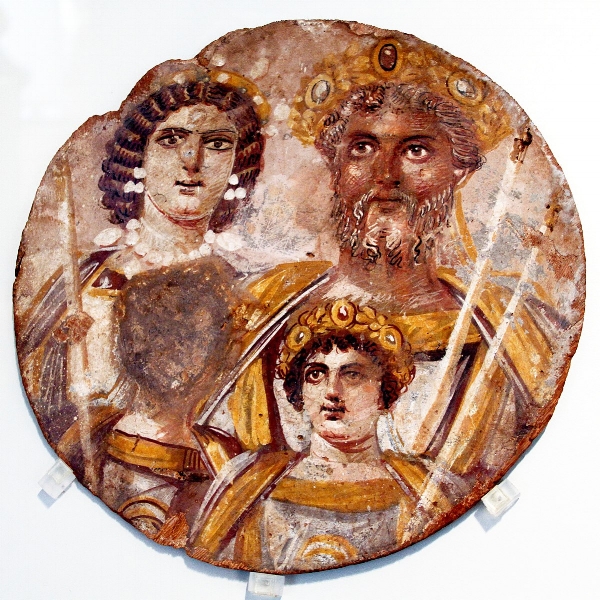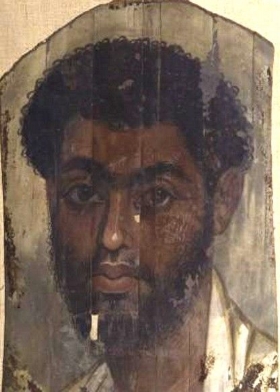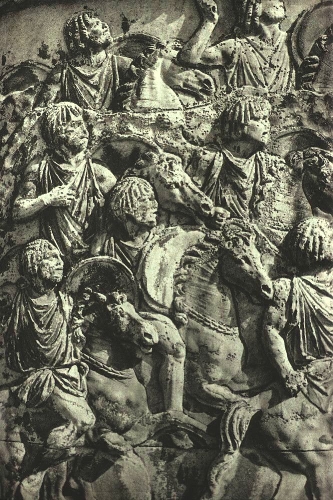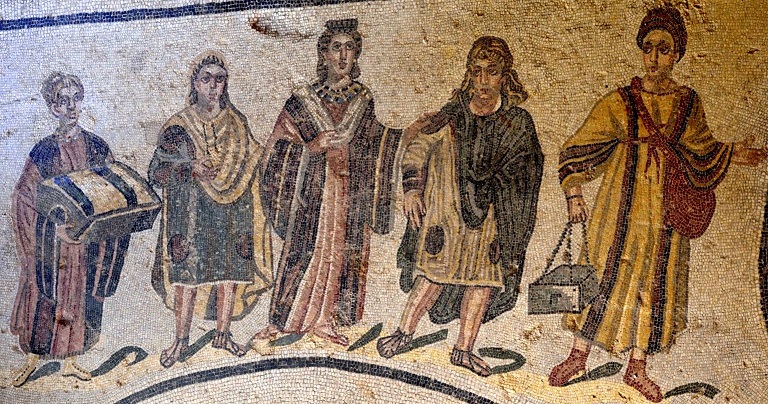In the summer of 1264, as England was buffeted by the storms of civil war, a band of men entered the royal forest of Sherwood, intent on poaching the king’s deer. Strangely enough, the expedition was led by Warin de Bassingborne, a stalwart supporter of the king, and Reginald de Grey the son of the Constable of Nottingham. The men they were leading were knights, squires and serjeants from the garrison of Nottingham Castle. Sherwood was a royal hunting reserve, and stealing the ‘vert and venison’ was a serious crime. Why were such staunch royalists apparently so keen to break the king’s law?
In May of that same year, Simon de Montfort and his baronial rebels had defeated King Henry III at the battle of Lewes and seized control of the kingdom. The constable and garrison of Nottingham, like those of several other royal castles including Windsor and Bristol, refused to recognise de Montfort’s authority, or to return baronial prisoners held within their walls. With the king a virtual prisoner and de Montfort issuing ‘royal’ commands for them to surrender, Constable John de Grey and his men clearly felt no guilt or scruple in supplementing the castle’s dwindling supplies with stolen venison.
The most famous figure associated with Sherwood Forest is, of course, Robin Hood – although some claim that he made his base in Barnsdale, further north. While stories about Robin were first recorded in the fifteenth century, they were probably composed as oral tales a century or more before that, and for many years historians and historical enthusiasts have suggested various real individuals who might have inspired the legends. Back in 1982, J.C. Holt popularised the idea that the ‘real’ Robin Hood may have been a thirteenth century brigand named Roger Godberd.
Sure enough, among the men who accompanied de Bassingborne and de Grey on their poaching expedition into Sherwood in 1264 were ‘Roger Gootbert and his brother Geoffrey’. Godberd – to use the more common spelling of his name – served at Nottingham until the end of that year. After that, however, his career takes an unusual turn. In less than a decade, this same Roger Godberd would turn from being a loyal soldier in a royal castle garrison into an effective and notorious outlaw chieftain, and an opponent of the very men he had once served. How did such a radical transformation come about?
Roger Godberd first turns up in legal records of the 1250s as the tenant of a plot of land in the manor of Swannington, part of the larger manor of Whitwick, in Leicestershire. J.C. Holt believed that Godberd’s landlord was Robert de Ferrers, Earl of Derby, but while the 1242 ‘Testa Nevill’ (Liber Foedorum, or Book of Fees) lists ‘Swaninton’ among the holdings of Earl Ferrers, Godberd is not listed among the tenants. A surer identification comes only a few years later: in a legal ruling of 1247 Swannington is held by Roger de Quincy, Earl of Winchester, as ‘belonging to his manor of Whitewick.’ Since Godberd and his descendants continued to hold land in Swannington of the heirs of Roger de Quincy, we can be fairly sure that he was the Earl of Winchester’s vassal from the beginning. If Ferrers also held a small part of the manor, it was not the bit tenanted by the Godberds.
From an early age, Roger Godberd seems to have been a quarrelsome and violent man, inclined to take the law into his own hands. In 1260 he was charged with ejecting one Jordan le Fleming from his land ‘with force and arms’, and stealing Jordan’s goods and chattels. Jordan claimed that Godberd had sublet (demised) his land in Swannington to him a year before. Since Godberd did not show up for the trial, it is possible that he was already making a living elsewhere. Perhaps by then he had found a new career as a paid sergeant or man at arms in a noble retinue. With England fast descending into civil war, plenty were doing the same.
On April 25th 1264, Roger de Quincy died without a male heir. The complex administration of his estates would take years, and in the meantime his tenant Roger Godberd was left without a master. Five days before de Quincy’s death King Henry and his army had been at Nottingham Castle. Following the royal victory over the Montfortians at Northampton earlier in the month, the baronial castellan of Nottingham had chosen to surrender without a fight – he changed sides only days later. In his stead, the king appointed Sir John de Grey, baron of Shirland in Derbyshire and one of the most prominent loyalists in the north, to hold both Nottingham and Bolsover castles in his name. ‘By occasion of disturbance of the realm,’ the order states, ‘it is necessary to munition them with victuals.’ The very next day, the king marched south again on the campaign that would lead him to disaster on the battlefield of Lewes in May 1264.
Quite possibly Roger Godberd joined the new garrison at Nottingham around this same time, or shortly afterwards. He may already have been serving in John de Grey’s retinue. Either way, he and his brother are first mentioned among the men that Reginald and Warin de Bassingborne led into Sherwood Forest that summer. The hunters made three expeditions in all, on August 10th and 24th, and September 1st, taking ‘one stag with their greyhounds in the field of Bullewell and one other stag in Beskwode [Bestwood]’, then taking ‘the venison as far as Bassingburne… one stag and one deer in the wood of Bullewell…and two deer in the wood of Novo Loco [Newstead]… and brought the venison to the aforesaid castle [of Nottingham].’
Writing under the king’s name and using his seal, de Montfort’s government directed repeated demands to John de Grey and his men to surrender the castle to the baronial sheriff. Only at the very end of the year did de Grey agree to their terms. Roger Godberd was still with him at that point – his name appears in a list of men, headed by John de Grey and his son, given safe conduct to depart on December 18th 1264: ‘Protection until Easter for John de Grey, late constable of the castle of Notingham, his men, lands and possessions; and safe conduct for him and his household in going to his lands, staying there and going thence whither he will…’
For over eighteen months after that, Roger Godberd leaves no trace in the historical sources. In the summer of 1265 Simon de Montfort was defeated at the Battle of Evesham and the king returned to power. John de Grey returned too, rewarded for his loyalty and appointed in February 1266 as Sheriff of Nottingham and Derby, charged with hunting down the bands of rebels and marauders who still infested the surrounding lands. ‘All persons of those counties’ were ordered to ‘aid to him with horses and arms and their whole posse in aggrieving and vanquishing all malefactors and disturbers of the peace… on the king’s behalf.’ If Roger Godberd was still serving in the powerful de Grey retinue then he may have formed a part of this counter-insurgency force – a case of poachers turned gamekeepers. Possibly, though, he had already changed sides, and become one of the insurgents himself. In March 1266 John de Grey died, and his son Reginald took over the post and the job.
On September the 8th 1266, the Saturday after the feast of the Nativity of the Blessed Mary, as Reginald de Grey and the king’s other lieutenants were busy crushing the last pockets of rebellion across England, Roger Godberd came to Garendon Abbey with a band of armed men. He ‘took and carried away by extortion,’ the indictment says, various deeds and charter documents concerning lands the abbot held of him, and financial obligations he had in turn made to the abbey. The following month, Roger and his band returned to Garendon, and ‘caused the said abbot and convent by force and compulsion to make him a certain charter of quittance concerning all the things, above-said.’ These relatively minor-seeming episodes of thuggery were reported to the king’s officials, and were the beginning of what would become Roger Godberd’s criminal career.
Garendon Abbey had been founded by Earl Roger de Quincy, Godberd’s former manorial lord – in fact the earl was buried there. The abbey’s lands were close to Earl Roger’s demesne manors of Groby, Shepshed and Whitwick, and adjoined those held by Godberd, and it seems likely that the abbot was playing a part in the administration of the earl’s inheritance. Previously, however, this same abbot had been a supporter of Simon de Montfort, who had endowed the abbey on several occasions. It is possible that the ‘charters’ mentioned in the indictment were connected to the tenancy held under de Quincy’s heirs, but there may be more to it; months later, Roger Godberd was briefly associated with another man, Roger de Reymes, a former servant or ‘valletus’ of Robert de Ferrers, Earl of Derby. De Reymes was accused of seizing land and property from those he alleged had once ‘abetted’ Simon de Montfort. Could it be that Roger Godberd was doing much the same at Garendon, and using the bitter aftermath of de Montfort’s downfall to settle old scores with the abbot?
Either way, Godberd’s actions criminalised him, as did those of de Reymes. Both men are listed in a royal summons of November 1266, demanding that they and other members of their gang surrender to royal justice and submit to the terms of the Dictum of Kenilworth. This was a legal document designed to facilitate the surrender of the rebel garrison of Kenilworth Castle, at that point under siege by the king. It allowed rebels and malefactors to earn royal pardon after paying a fine based on the value of their land. That Roger Godberd was indicted in this way has led many historians – including J.C. Holt – to assume that he himself had been a Montfortian supporter, and was now one of the ‘Disinherited’ rebels holding out against the king. Until he began causing trouble at Garendon, however, Godberd appears to have served the king’s men loyally. As with Roger de Reymes, his was a crime of attempted extortion and property theft, not of rebellion. In the autumn of 1266, the king was using the overarching legal mechanism of the Dictum of Kenilworth to deal with any and all the crimes that plagued his realm, and all those who ‘disturbed the king’s peace’.
On December 10th, Godberd and his brother William made the journey to Kenilworth and submitted to the king in his siege camp before the castle walls. They were granted pardon ‘of all their trespasses and forfeitures in the time of the late disturbance on condition of their good behaviour,’ and told that ‘the lands which they now hold shall not incur loss thereby provided that they stand to the award of Kenilworth… And if they offend against their fealty again their bodies shall be at the king’s will, and their lands shall fall to the king and his heirs forever.’ While this sounds very much like the pardon of a rebel, nowhere in the ruling is Godberd described as a ‘king’s enemy’, and he is said to still hold at least some of his lands at the time. Clearly he had not been disinherited, and he was not, and had never been, a Montfortian.
After this, Roger Godberd once more fades into the background of history. His lands in Swannington and nearby Shepsted seem to have been inherited by Earl Roger de Quincy’s widow, Countess Eleanor, as part of her dower estates. Eleanor was the sister of Robert de Ferrers, the rebellious Earl of Derby, but her own allegiances are made clear by her remarriage, some time in 1266, to Roger de Leyburne, the ultra-loyal ‘king’s knight’ who had spend the previous months crushing rebellions all across the land. In December of that year de Leyburne was appointed Constable of Nottingham, as successor to Reginald de Grey. His task was the same, and from April until September of 1267 he was engaged in leading a powerful force of knights and men at arms into Duffield Frith and nearby Charnwood, to bring to justice the bands of outlaws who still sheltered there. Did Roger Godberd serve in the retinue of his new manorial lord, or was he by this time already one of de Leyburne’s opponents?
Towards the end of 1269 de Leyburne was sent to Gascony by the king. We have no way of knowing whether Roger Godberd accompanied him. If he did, he was apparently back in England less than a year later. Around Michaelmas 1270 he was accused of participating in another attack on an abbey, and a much more serious one than his affray at Garendon. This time the target was Stanley, in distant Wiltshire. Roger Godberd, so the charge sheet read, ‘together with other evildoers, wickedly robbed the Abbey of Stanley in the said county of Wiltshire of a great sum of money, horses, and other things found there, and also [caused] the death of a certain monk killed there…’
It may seem strange that a man formerly based solely in the North Midlands should be leading an attack so far away. Stranger still, the Annals of Dunstable Priory allege that Stanley was attacked by former baronial rebels who had been hiding out in the marshes of Ely since the war. Four of these men were captured at Dunstable months later and sent to Newgate Prison; all were well armed and well mounted, the annalist claims, but while two were knights a third was ‘a certain Geoffrey’ (Galfridus). Roger Godberd had a brother named Geoffrey – could it be that his supposed participation in the raid on Stanley Abbey was a case of mistaken identity?
By the summer of 1271 Godberd had become the leader of a large band of robbers and reavers operating in Sherwood Forest and the surrounding counties. News of their depredations soon reached the king, who was informed by ‘the prelates, magnates and nobles of the realm’ that ‘outlaws, robbers, thieves and malefactors, mounted and on foot, in the counties of Nottingham, Leicester and Derby, wandering by day and night’ were causing ‘so many and great homicides and robberies… that no one with a small company could pass through those parts without being taken and killed or spoiled of his goods.’ Roger Godberd, the report continued, was ‘leader and captain of the malefactors.’
One of Godberd’s associates at this time was a man named Walter Devyas or de Ewyas/Deuyas, who was perhaps the brother of John Devyas, a Yorkshire knight who in turn had served Robert de Ferrers at one point. Clearly Godberd and his gang had some links with de Ferrers, who at this time was once more stirring up trouble, and had lately seized an estate from Roger de Leyburne. But they may have had connections elsewhere too: Devyas had already been pardoned once on a charge of murder, on the recommendation of Lord Edward, the king’s son.
At a place called Nordgrange (possibly a grange or estate belonging to Rufford Abbey, in Sherwood Forest), Godberd and Devyas with four of their gang were captured in June 1271, by Hugh de Babington – a cartulary document of the following year identifies him as Sheriff of Nottingham and Derby. De Babington took the captives back to Nottingham Castle and imprisoned them, but later ‘allowed them to leave the prison,’ for an unknown reason. Godberd and Devyas sought the protection of a local knight, Richard Foliot, in his castle at Fenwick. Foliot had formerly been a king’s man, but like Godberd himself his allegiances seem to have become rather frayed at some point in the complicated aftermath of the Barons’ War. A ruling of October the 15th empowered Foliot to ‘conduct Walter Deuyas, charged with divers trespasses, to the king.’ But he did not.
Foliot was duly ‘indicted of the harbouring of Walter de Euyas, Roger Godberd and other Wrongdoers,’ and the Sheriff of Yorkshire, Roger L’Estrange, was sent to Fenwick to demand he hand over the fugitives. Godberd and Devyas once more made their escape, and Foliot was compelled to give his son as a hostage to guarantee his future good behaviour, and to stand trial at York. Walter Devyas fled into the north, presumably searching for more powerful protectors. For a while he was harboured by Gilbert de Umfraville at Prudhoe in Northumberland, and later still he and his gang inflicted a considerable defeat on Roger L’Estrange and his posse, carrying away their horses and armour. But the law caught up with Devyas in the end, and he was summarily beheaded without trial.
In the meantime Roger Godberd had also gathered a new outlaw band and resumed his depredations. In the end it was his former master Reginald de Grey, the very man whom he had followed into Sherwood in 1264, who was sent to bring him to justice. ‘Perceiving that without greater force and stouter pursuit these [brigands] could not be taken or driven from the counties,’ the king ‘ordered that 100 marks should be levied… and paid to Reynold de Grey to attack them.’ Sadly, details of what happened next are very sparing. All we know is that de Grey succeeded in his mission against the outlaws. On February the 11th 1272, he was reported to have ‘pursued them manfully and captured one Roger Godberd, their leader and master, and delivered him to prison.’
England by this time was once again slipping into a fractious state. King Henry died in November of that year, with his son and heir Lord Edward still overseas making a leisurely progress home from the Holy Land. In Edward’s absence, the kingdom was ruled by a council of powerful barons and courtiers. This state of political uncertainty may help to explain what happened to Godberd over the next few years.
The captured brigand was first imprisoned in Bridgnorth Castle. By the following year, 1273, he was being held at Chester instead, and the royal justices of the new King Edward ordered an inquiry into his capture. In 1275 Godberd was in prison at Hereford, and from there on December the 26th he was taken to Newgate in London, where he would finally stand trial for his offences. Strangely, however, in August of 1274 Roger Godberd had brought a legal case against Countess Eleanor over the tenancy of his lands in Shepshed. Had he perhaps been let out of prison for a while, only to be rearrested at a later date?
In the text of the gaol delivery order, Godberd is ‘accused as a public criminal of many burglaries, homicides, arsons, and robberies committed by him in the counties of Leics, Notts, and Wilts.’ Roger himself ‘denies all burglaries, homicides, arsons, robberies and all larceny… except at the time of the disturbance recently happening in the kingdom between the lord king Henry and Simon, former earl of Leicester, and his accomplices.’ He goes on to state that he was pardoned for all his acts up until the 9th of December 1266, when the king ‘received him into his peace.’ Since then, he claims, he has ‘conducted himself well and faithfully towards the said king and his heirs and everybody else, and that he is not guilty of any of the foregoing.’ His trial was set for three weeks after Easter 1276, to be held before the justice John de Cobham and a jury of twelve men.
We tend to assume that medieval justice was both swift and brutal. For Walter Devyas it certainly had been, but for Roger Godberd the opposite seems to have been the case. He had already been held in various jails for several years – albeit perhaps with intervals of freedom – but despite what would seem to have been a clear case against him, there is no record of his trial ever taking place or of a verdict being declared. Amazingly, it seems that Roger Godberd, former ‘leader and captain of malefactors’, escaped the noose and was released from prison and allowed to return home.
Unfortunately we have no further clues about his apparent liberation. It could be that the new King Edward decided to show leniency to a man who had loyally served his father during the Barons’ War. It could be that the jurymen came to doubt his involvement with some of the alleged incidents. Or maybe they felt that after so many years in prison he had already suffered enough for what by then may have seemed rather distant and dubious offences. Perhaps, like two of the men captured at Dunstable after the attack on Stanley Abbey, he was simply ‘freed by a corrupt jury.’ Sadly, we can never know.
In 1276 an assize court in Leicestershire met to decide whether ‘Roger Godberd and Roger his son’ had unjustly dispossessed another man of a pasture in Swannington. Was the former brigand already back in possession of his lands by this date? Roger de Leyburne had died in 1271 and Countess Eleanor had not remarried. She herself died by December 1274, with her dower lands being divided among the husbands of her daughters. At some point in late 1277 or 1278, ‘Roger son of Roger Godberd’ was once again conducting legal proceedings over the Shepsted tenancy, this time against Margaret de Ferrers, Countess of Derby, one of Countess Eleanor’s daughters. Swannington, meanwhile, had been inherited by Alexander Comyn, Earl of Buchan and husband of Eleanor’s older daughter. By 1282, if not before, the Godberds were holding Swannington of the Comyns. Earl Alexander passed the manor to his son John Comyn, from whom it passed in turn to Henry de Lacy, Earl of Lincoln. A Roger Godberd was still holding land in Swannington of the de Lacys in 1311.
It is difficult in these cases to distinguish the father from the identically-named son, but it is at least possible that the former outlaw Godberd survived into the 1280s or beyond. In 1287 the long-belated inquest before the Forest Eyre into the 1264 poaching expedition in Sherwood Forest mentions that Godberd and his brother ‘have lands in the county of Leicestershire’, implying that both men were still alive at the time.
Whether Roger Godberd really was one of the inspirations for the legend of Robin Hood is also impossible to say. If so, he was certainly not the only one. But perhaps more importantly, what we can piece together of his life and career gives us a tantalising glimpse of the exploits of an ordinary man of the thirteenth century who, very briefly, emerged from the shadows of the distant past.
(I first came across most of the above details during the research for my novel ‘King’s Enemy’, which features some episodes of outlawry - and even some set in Sherwood Forest. My thanks go to David Pilling and Robert Lynley for their helpful discussions of the topic.
This seems a good enough excuse to mention that the UK paperback edition of the book will be published on March 26th 2025. Please do pre-order it now!)











